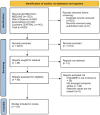Association between N-terminal pro-brain natriuretic peptide levels and outcomes of ischemic stroke: A systematic review and meta-analysis
- PMID: 40577313
- PMCID: PMC12204559
- DOI: 10.1371/journal.pone.0322816
Association between N-terminal pro-brain natriuretic peptide levels and outcomes of ischemic stroke: A systematic review and meta-analysis
Abstract
Background: N-terminal pro-brain natriuretic peptide (NT-proBNP) was identified as an important biomarker of cardiovascular disease, in ischemic stroke. This study intends to assess the association of NT-proBNP levels with clinical outcomes of patients ischemic stroke patients.
Methods: A comprehensive search of MEDLINE, Web of Science, ScienceDirect, and Cochrane CENTRAL electronic databases was done for papers published till April 2024 and reporting on the levels of NT-proBNP in patients with ischemic stroke. Outcomes of interest included mortality (all-cause and cardiovascular) and neurological, and functional outcomes. A random-effects meta-analysis model was used, and final estimates were reported as pooled odds ratio (OR) with 95% confidence interval (CI).
Results: Elevated NT-proBNP levels were significantly linked to increased all-cause (pooled OR = 2.322, 95% CI: 1.718 to 2.925) and cardiovascular mortality (pooled OR = 1.797, 95% CI: 1.161 to 2.433). Higher NT-proBNP levels were also related to poorer functional outcomes (pooled OR = 1.129, 95% CI: 1.041 to 1.217). Patients with higher NT-proBNP levels had somewhat worse neurological outcomes (pooled OR = 1.317, 95% CI: 0.859 to 1.774). Considerable heterogeneity was detected across the studies (I² > 40% in most analyses).
Conclusion: NT-proBNP levels may serve as a robust predictor of mortality and offer potential utility in predicting functional recovery in ischemic stroke patients. The integration of NT-proBNP measurement into clinical settings may be beneficial for risk stratification and management of stroke survivors.
Copyright: © 2025 Zhang et al. This is an open access article distributed under the terms of the Creative Commons Attribution License, which permits unrestricted use, distribution, and reproduction in any medium, provided the original author and source are credited.
Conflict of interest statement
The authors have declared that no competing interests exist.
Figures










Similar articles
-
The comparative and added prognostic value of biomarkers to the Revised Cardiac Risk Index for preoperative prediction of major adverse cardiac events and all-cause mortality in patients who undergo noncardiac surgery.Cochrane Database Syst Rev. 2021 Dec 21;12(12):CD013139. doi: 10.1002/14651858.CD013139.pub2. Cochrane Database Syst Rev. 2021. PMID: 34931303 Free PMC article.
-
Accuracy of NT-proBNP for predicting mortality amongst patients with ischemic stroke: a systematic review and meta-analysis.BMC Med. 2025 Aug 15;23(1):476. doi: 10.1186/s12916-025-04299-1. BMC Med. 2025. PMID: 40817230 Free PMC article.
-
Role of NT-proBNP for Atrial Fibrillation Detection After Ischemic Stroke: A Time-Dependent Relationship.Stroke. 2025 Jul;56(7):1704-1713. doi: 10.1161/STROKEAHA.124.049249. Epub 2025 Apr 21. Stroke. 2025. PMID: 40255172
-
Brain natriuretic peptide and N-terminal brain natriuretic peptide for the diagnosis of haemodynamically significant patent ductus arteriosus in preterm neonates.Cochrane Database Syst Rev. 2022 Dec 8;12(12):CD013129. doi: 10.1002/14651858.CD013129.pub2. Cochrane Database Syst Rev. 2022. PMID: 36478359 Free PMC article.
-
Brain natriuretic peptide as a predictive marker of mortality in sepsis: an updated systematic review and meta-analysis.BMC Anesthesiol. 2024 Aug 7;24(1):276. doi: 10.1186/s12871-024-02661-z. BMC Anesthesiol. 2024. PMID: 39112946 Free PMC article.
References
Publication types
MeSH terms
Substances
LinkOut - more resources
Full Text Sources
Medical
Research Materials
Miscellaneous

